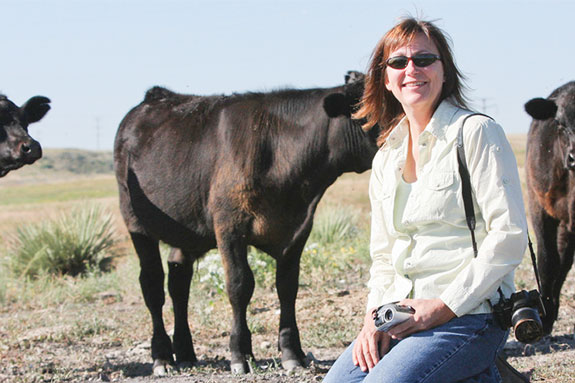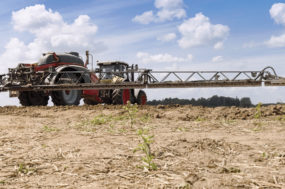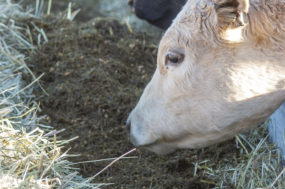How many more cows could you run? What would it mean to your bottom line? The good news is that this isn’t like imagining what you would do if you won the lottery.
In this case, you’ve already won and that forage is probably in your pasture right now. You’ve just been calling it “weeds.”
Economist John Morley estimates, based on average pasture weed, that if your cattle ate 70 percent of those weeds you’d have 43 percent more forage.
Even better, the nutritional value of these weeds is at least as good as your grass and often the equivalent of alfalfa. Last, but not least, anyone can train their cows to eat weeds in just 10 hours over 10 days using a simple method I developed.
The method was developed in 2004 when teaching cows to eat Canada thistle, leafy spurge and spotted knapweed at Grant-Kohrs Ranch National Historic Site in Montana.
Click here or scroll down to watch a video on the economics of teaching cows to eat weeds.
Since then I have trained over 1,200 animals (and 32 of Ted Turner’s bison) to eat many of our most problematic weeds. The method works because it is based on animal behavior science and decades of research about how animals choose what to eat.
I begin the training process by making sure the target weed is safe to eat. All plants contain toxins but over the past eight grazing seasons, I’ve found very few weeds that are unsafe to train cattle to eat. I never teach cows to eat anything that could cause abortion, birth defects or illness.
Once I know that the plant is safe for cows to eat, I pick the trainees. While I used to prefer training heifers, now I choose the animals that work best logistically.

Heifers are great. Cow/calf pairs also work well. And if you’re working with stockers, pull a small group out, train them and then let them train the rest. Because trainees teach their offspring and herdmates, I will usually train between 20 and 50 animals.
I have found that it’s a lot more efficient and effective to let one cow train another, and they usually get the job done in the first week they’re with an ‘uneducated’ group.
Getting a cow to put a weed in her mouth is as simple as getting her used to trying lots of new foods. Training begins in pasture, with me calling the cows in to feed tubs.
Then, for four days, morning and afternoon, trainees are fed a snack of some unusual but very nutritious food. I go down to the feed co-op and buy eight different kinds of feed my trainees have never seen before.
It could be alfalfa pellets, rolled oats, wheat bran, whatever they have on hand. I just focus on picking things with different flavors, textures and smells. Though each food is different, what they have in common is good protein content. It’s kind of like feeding them all different kinds of candy.
By the second day they run to the feed tubs when I show up, knowing I’m bringing them something good, even if it looks or smells a little strange.
On the fifth day, I break the routine and skip the morning feeding. In the afternoon, I pick some of the target weed and mix it with a food the trainees have tried before.
It takes about 30 to 45 minutes to cut enough weeds for each feeding. For 50 cows I cut enough weeds to loosely fill about two of the 250-pound supplement tubs. This is repeated on days six and seven, reducing the feed mixed in on day six and feeding plain weeds on day seven.
Different groups respond differently to training. With some groups I train the full seven days. With others I stop after day five because as soon as they try the weed from the tub, they look around and start eating it in pasture.
This works for two reasons. First, from the trainee’s perspective, I’ve always given them good things to eat and this is just one more strange-looking food in a series of strange foods. Second, the weeds are really nutritious, with the same good protein values as the foods they’ve been trying. When the cow experiences the good nutritional feedback from the plant, she decides it’s a good thing to eat.
But what about prickly weeds? My experience shows they aren’t a problem. Cows in training have eaten prickly plants, even Italian thistle with its half-inch spines; they’ve never been injured and they’ve gone on to eat them happily in pasture.
Since I started training, I have found that once cows are introduced to the idea that food might be something other than grass, they go on to try all kinds of weeds on their own, even thorny plants like multi-flora rose, blackberry and more.
I worked with goats for seven years before learning to train cows to eat weeds, and I can say that my cow trainees are every bit as good at brush and weed management as goats ever were.
I have also found that, given variety in pasture, cows choose and mix forages safely. In eight grazing seasons, no cow has ever gotten sick or injured as a result of eating weeds.
They gain weight at or above expected rates and breed back and calve normally. I attribute this to the natural internal feedback mechanism described by researchers as the subconscious tool animals use to choose what to eat (See "What is palatability" paragrah below).
I decided to figure out how to teach cows to eat weeds when ranchers I met said they weren’t interested in having goats or sheep in their pastures to graze down weeds. Now I’m just trying to figure out how I train people to try something new and different. FG
What is palatability?
Researchers at Utah State University say that palatability is not so much a matter of taste but rather internal feedback about nutritional value. Nerves from the mouth and nose take information to the brain about taste and smell. Then nerves from the rumen take feedback about the nutrients and toxins in the foods. The brain matches feedback from the rumen to the taste and smell. Nutritious foods tend to taste “good” and an animal will eat more of them, but animals reduce the amount they eat of foods high in toxins.
PHOTO
TOP RIGHT: This calf is eating a musk thistle just like his mom taught him to do. I taught this herd to eat late-season diffuse knapweed in 2007 and they have gone on to choose everything in the pasture.
MIDDLE RIGHT: Kathy Voth teaches a cow to weed out new forages. Photo courtesy of Kathy Voth.
Click here to learn more about training cows to eat weeds.










